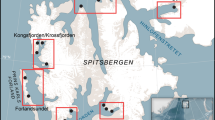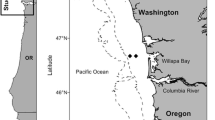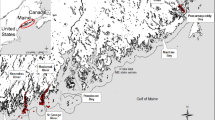Abstract
To understand the factors that regulate early marine survival of juvenile Chinook (Oncorhynchus tshawytscha) and coho (Oncorhynchus kisutch) salmon, it is necessary to characterize their prey availability, selectivity, and dietary niche widths. Currently, no sampling protocol exists that directly measures the salmonid prey field and quantifies dietary niche width via stable isotope analysis (SIA). The main goals of this study were to quantify the dietary niche widths of juvenile salmon and to compare environmental prey community compositions to juvenile salmon diets. Juvenile Chinook and coho salmon and their prey were collected in the northern California Current ecosystem via herring and Nordic trawls during 9–15 June 2010. The catch per unit effort of the salmonid prey field was compared to juvenile salmon stomach contents, and a Manly–Chesson index was used to quantify prey selectivity. Salmon and their prey were measured for δ13C and δ15N values and salmon were analyzed via Stable Isotope Bayesian Ellipses in R. Results indicated that there was no significant difference between juvenile Chinook and coho salmon diets and that they principally consumed rockfish juveniles (Sebastes spp.) and Cancer megalopae. Juvenile salmon consumed somewhat different prey items compared to both herring and Nordic nets and these nets sampled different assemblages of similar prey communities. Though juvenile salmon were in isotopic disequilibrium with their marine prey, both species occupied similar isotopic niche widths. These results demonstrate that SIA provides complementary information to stomach content analysis.






Similar content being viewed by others
References
Abrams PA, Rowe L (1996) The effects of predation on the age and size of maturity of prey. Evol Int J Org Evol 50:1052–1061
Agrawal AA (2001) Phenotypic plasticity in the interactions and evolution of species. Science 294:321–326
Anderson GO (2006) Variations in estuarine life history diversity of juvenile Chinook salmon based on stable isotope analysis of food web linkages. Master’s thesis, University of Washington, Seattle
Auth TD, Brodeur RD, Peterson JO (2015) Anomalous ichthyoplankton distributions and concentrations in the northern California Current during the 2010 El Niño and La Niña events. Prog Oceanogr 137:103–120
Baldwin RE, Miller TW, Brodeur RD, Jacobson KC (2008) Expanding the foraging history of juvenile Pacific salmon: combining stomach-content and macroparasite-community analyses for studying marine diets. J Fish Biol 72:1268–1294
Barth JA, Menge BA, Lubchenco J, Chan F, Bane JM, Kirincich AR, McManus MA, Nielsen KJ, Pierce SD, Washburn L (2007) Delayed upwelling alters nearshore coastal ocean ecosystems in the northern California Current. Proc Natl Acad Sci USA 104:3719–3724
Bollens SM, Hooff R, Butler M, Cordell JR, Frost BW (2010) Feeding ecology of juvenile Pacific salmon (Oncorhynchus spp.) in a northeast Pacific fjord: diet, availability of zooplankton, selectivity for prey, and potential competition for prey resources. Fish Bull 108:393–407
Brodeur RD (1989) Neustonic feeding by juvenile salmonids in coastal waters of the Northeast Pacific. Can J Zool 67:1995–2007
Brodeur RD (1991) Ontogenetic variations in the type and size of prey consumed by juvenile coho, Oncorhynchus kisutch, and chinook, O. tshawytscha, salmon. Environ Biol Fishes 30:303–315
Brodeur RD, Morgan CA (2016) Influence of a coastal riverine plume on the cross-shelf variability in hydrography, zooplankton, and juvenile salmon diets. Estuar Coasts 39:1183–1198
Brodeur RD, Pearcy WG (1990) Trophic relations of juvenile Pacific salmon off the Oregon and Washington coast. Fish Bull 88:617–636
Brodeur RD, Fisher JP, Teel D, Emmett RL, Casillas E, Miller TW (2004) Juvenile salmonid distribution, growth, condition, origin, environmental and species associations in the Northern California Current. Fish Bull 102:25–46
Brodeur RD, Seki MP, Pakhomov EA, Suntsov AV (2005) Micronekton—what are they and why are they important? PICES Press 13:7–11
Brodeur RD, Daly EA, Schabetsberger RA, Mier KL (2007) Interannual and interdecadal variability in juvenile coho salmon (Oncorhynchus kisutch) diets in relation to environmental changes in the northern California Current. Fish Oceanogr 16:395–408
Brodeur RD, Daly EA, Benkwitt CE, Morgan CA, Emmett RL (2011) Catching the prey: Sampling juvenile fish and invertebrate prey fields of juvenile coho and Chinook salmon during their early marine residence. Fish Res 108:65–73
Chesson J (1978) Measuring preference in selective predation. Ecology 59:211–215
Chesson J (1983) The estimation and analysis of preference and its relationship to foraging models. Ecology 64:1297–1304
Clarke KR, Warwick RM (2001) Change in marine communities: an approach to statistical analysis and interpretation. Second Ed. Primer-E Ltd., Plymouth Marine Laboratory, Plymouth
Dale KE, Daly EA, Brodeur RD (2017) Interannual variability in the feeding and condition of subyearling Chinook salmon off Oregon and Washington in relation to fluctuating ocean conditions. Fish Oceanogr 26:1–16
Daly EA, Brodeur RD (2015) Warming ocean conditions relate to increased trophic requirements of threatened and endangered salmon. PLoS One 10(12):e0144066
Daly EA, Brodeur RD, Weitkamp LA (2009) Ontogenetic shifts in diets of juvenile and subadult coho and chinook salmon in coastal marine waters: important for marine survival? Trans Am Fish Soc 138:1420–1438
Daly EA, Auth TD, Brodeur RD, Peterson WT (2013) Winter ichthyoplankton biomass as a predictor of early summer prey fields and survival of juvenile salmon in the northern California Current. Mar Ecol Prog Ser 484:203–217
DeRobertis A, Morgan CA, Schabetsberger RA, Zabel RW, Brodeur RD, Emmett RL, Knight CM, Krutzikowsky GK, Casillas E (2005) Columbia River plume fronts. II. Distribution, abundance, and feeding ecology of juvenile salmon. Mar Ecol Prog Ser 299:33–44
Duffy EJ, Beauchamp DA, Sweeting RM, Beamish RJ, Brennan JS (2010) Ontogenetic diet shifts of juvenile Chinook salmon in nearshore and offshore habitats of Puget Sound. Trans Am Fish Soc 139:803–823
Fry B (2006) Stable isotope ecology. Springer, New York
Fry B, Wainright SC (1991) Diatom sources of 13C-rich carbon in marine food webs. Mar Ecol Prog Ser 76:149–157
Goericke R, Fry B (1994) Variations in marine plankton δ13C with latitude, temperature, and dissolved CO2 in the world ocean. Glob Biogeochem Cycles 8:85–90
Graham BS, Koch PL, Newsome SD, McMahon KW, Aurioles D (2010) Using isoscapes to trace the movements and foraging behavior of top predators in oceanic ecosystems. In: West JB, Bowen GJ, Dawson TE, Tu KP (eds) Isoscapes: understanding movement, pattern, and process on Earth through isotope mapping. Springer Dordrecht Heidelberg, Dordrecht, pp 273–298
Heard WR, Shevlyakov E, Zikunova OV, McNicol RE (2007) Chinook salmon—trends in abundance and biological characteristics. North Pac Anad Fish Comm 4:77–91
Hertz E, Trudel M, Brodeur RD, Daly EA, Eisner L, Farley EV Jr, Harding JA, MacFarlane RB, Mazumder S, Moss JH (2015) Continental-scale variability in the feeding ecology of juvenile Chinook salmon along the coastal Northeast Pacific Ocean. Mar Ecol Prog Ser 537:247–263
Hertz E, Trudel M, El-Sabaawi R, Tucker S, Dower JF, Beacham TD, Edwards AM, Mazumder A (2016) Hitting the moving target: modelling ontogenetic shifts with stable isotopes reveals the importance of isotopic turnover. J Anim Ecol 85:681–691
Hickey BM, Banas NS (2003) Oceanography of the U.S. Pacific Northwest Coastal Ocean and estuaries with application to coastal ecology. Estuaries 26:1010–1031
Huyer A (1983) Coastal upwelling in the California current system. Prog Oceanogr 12:259–284
Jackson AL, Inger R, Parnell AC, Bearhop S (2011) Comparing isotopic niche width among and within communities: SIBER – Stable Isotope Bayesian Ellipses in R. J Anim Ecol 80:595–602
Johnson SP, Schindler DE (2009) Trophic ecology of Pacific salmon (Oncorhynchus spp.) in the ocean: a synthesis of stable isotope research. Ecol Res 24:855–863
Lasker R, Feder HM, Theilacker GH, May RC (1970) Feeding, growth, and survival of Engraulis mordax larvae reared in the laboratory. Mar Biol 5:345–353
Laws ED, Popp BN, Bidigare RR, Kennicutt MC, Macko SA (1995) Dependence of phytoplankton carbon isotopic composition on growth rate and [CO2]aq: theoretical considerations and experimental results. Geochim Cosmochim Acta 59:1131–1138
Layman CA, Arrington DA, Montana C, Post DM (2007) Can stable isotope ratios provide for community-wide measures of trophic structure? Ecology 88:42–48
Link JS, Keen RE (1999) A model of salmonid planktivory: field test of a mechanistic approach to size-selection. Ecol Model 117:269–283
Litz MNC, Miller JA, Copeman LA, Teel DJ, Weitkamp LA, Daly EA, Claiborne AM (2016) Ontogenetic shifts in the diets of juvenile Chinook Salmon: new insight from stable isotopes and fatty acids. Environ Biol Fish. doi:10.1007/s10641-016-0542-5
Logerwell EA, Mantua N, Lawson PW, Francis RC, Agostini VN (2003) Tracking environmental processes in the coastal zone for understanding and predicting Oregon coho (Oncorhynchus kisutch) marine survival. Fish Oceanogr 12:554–568
Manly BFJ (1974) A model for certain types of selection experiments. Biometrics 30:281–294
McConnaughey T, McRoy CP (1979) Food-web structure and the fractionation of carbon isotopes in the Bering Sea. Mar Biol 53:257–262
McMahon KW, Hamady LL, Thorrold SR (2013) A review of ecogeochemistry approaches to estimating movements of marine animals. Limnol Oceanogr 58:697–714
Methot RD (1986) A frame trawl for sampling juvenile fish. CalCOFI Rep 27:267–278
Miller TW (2006) Trophic dynamics of marine nekton and zooplankton within the northern California Current pelagic ecosystem. Dissertation. Oregon State University, Corvallis
Miller TW, Brodeur RD, Rau HG (2008) Carbon stable isotopes reveal relative contribution of shelf-slope production to the Northern California Current pelagic community. Limnol Oceanogr 53:1493–1503
Naman SM, Greene CM, Rice CA, Chamberlin J, Conway-Cranos L, Cordell JR, Hall JE, Rhodes LD (2016) Stable isotope-based trophic structure of pelagic fish and jellyfish across natural and anthropogenic landscape gradients in a fjord estuary. Ecol Evol doi:10.1002/ece3.2450
Norton EC, MacFarlane RB, Mohr MS (2001) Lipid class dynamics during development in early life stages of shortbelly rockfish and their application to condition assessment. J Fish Biol 58:1010–1024
Pearcy WG (1992) Ocean Ecology of North Pacific Salmon. Washington Sea Grant Program. University of Washington Press, Seattle, p 179
Pearcy WG, Fisher JP (1988) Migrations of coho salmon, Oncorhynchus kisutch, during their first summer in the ocean. U.S. National Marine Fisheries Service. Fish Bull 86:173–195
Pepin P (1995) An analysis of the length-weight relationship of larval fish: limitations of the general allometric model. Fish Bull 93:419–426
Peterson BJ, Fry B (1987) Stable isotopes in ecosystem studies. Annu Rev Ecol Syst 18:293–320
Peterson WT, Brodeur RD, Pearcy WG (1982) Food habits of juvenile salmon in the Oregon coastal zone, June 1979. Fish Bull US 80:841–851
Phillips DL, Newsome SD, Gregg JW (2005) Combining sources in stable isotope mixing models: alternative methods. Oecologia 144:520–527
Post DM, Layman CA, Arrington DA, Takimoto G, Quattrochi J, Montana G (2007) Getting to the fat of the matter: models, methods, and assumptions for dealing with lipids in stable isotope analyses. Oecologia 152:179–189
R Developmental Core Team (2010) R: a language and environment for statistical computing. R Foundation for Statistical Computing, Vienna
Ramos R, Gonzalez-Solis J (2012) Trace me if you can: the use of intrinsic biogeochemical markers in marine top predators. Front Ecol Environ 10:258–266
Roegner GC, Daly EA, Brodeur RD (2013) Surface distribution of brachyuran megalopae and ichthyoplankton in the Columbia River plume during transition from downwelling to upwelling conditions. Cont Shelf Res 60:70–86
Schabetsberger R, Morgan CA, Brodeur RD, Potts CL, Peterson WT, Emmett RL (2003) Prey selectivity and diel feeding chronology of juvenile chinook (Oncorhynchus tshawytscha) and coho (O. kisutch) salmon in the Columbia River plume. Fish Oceanogr 12:523–540
Shenker JM (1988) Oceanographic associations of neustonic larval and juvenile fishes and Dungeness crab megalopae off Oregon. Fish Bull 86:299–317
Strong KW, Daborn GR (1979) Growth and energy utilisation of the intertidal isopod Idotea baltica (Pallas) (Crustacea: Isopoda). J Exp Mar Biol Ecol 41:101–123
Tieszen LL, Boutton TW, Tesdahl KGC, Slade NA (1983) Fractionation and turnover of stable carbon isotopes in animal tissues: implications for δ13C analysis of diet. Oecologia 57:32–37
Tomaro LM, Teel DJ, Peterson WT, Miller JA (2012) When is bigger better? Early marine residence of middle and upper Columbia River spring Chinook salmon. Mar Ecol Prog Ser 452:237–252
Vander Zanden MJ, Rasmussen JB (2001) Variation in δ15N and δ13C trophic fractionation: implications for aquatic food web studies. Limnol Oceanogr 46:2061–2066
Weitkamp LA, Sturdevant MV (2008) Food habits and marine survival of juvenile Chinook and coho salmon from marine waters of Southeast Alaska. Fish Oceanogr 17:380–395
Weitkamp LA, Teel DJ, Liermann M, Hinton SA, Van Doornik DM, Bentley PJ (2015) Stock-specific size and timing at ocean entry of Columbia River juvenile salmon and steelhead: implications for early ocean growth. Marine and Coastal. Fisheries 7:370–392
West-Eberhard MJ (2005) Developmental plasticity and the origin of species differences. Proc Nat Acad Sci 102:6543–6549
Acknowledgements
We would like to acknowledge Greg Hutchinson, Curtis Roegner, Caren Barceló, Marisa Litz, Keith Bosley, Toby Auth, and Jason Phillips for assistance in sample collection, Jennifer McKay for assistance in SIA, Andrew Parnell, Andrew Jackson, and Don Phillips for intellectual guidance, and Andrew Jackson for help with the SIBER analysis. We would also like to acknowledge Eric Ward, Correigh Greene, Eric Hertz, Chris Harrod, and two anonymous reviewers for providing useful comments on this manuscript. This study was financially supported by the Bonneville Power Administration and the first author was supported in part by the ASSURE program of the Department of Defense in partnership with the National Science Foundation Research Experience for Undergraduates Site program under Grant No. OCE-1263349.
Author information
Authors and Affiliations
Corresponding author
Ethics declarations
Conflict of interest
The authors declare that they have no conflict of interest.
Ethical approval
All applicable international, national, and/or institutional guidelines for the care and use of animals were followed.
Human and animal rights
This article does not contain any studies with human participants. All fish and invertebrate specimens were collected in accordance with the guidelines of the state and federal collection permits granted for this study.
Additional information
Responsible Editor: C. Harrod.
Reviewed by undisclosed experts.
Rights and permissions
About this article
Cite this article
Adams, J.N., Brodeur, R.D., Daly, E.A. et al. Prey availability and feeding ecology of juvenile Chinook (Oncorhynchus tshawytscha) and coho (O. kisutch) salmon in the northern California Current ecosystem, based on stomach content and stable isotope analyses. Mar Biol 164, 98 (2017). https://doi.org/10.1007/s00227-017-3095-z
Received:
Accepted:
Published:
DOI: https://doi.org/10.1007/s00227-017-3095-z




